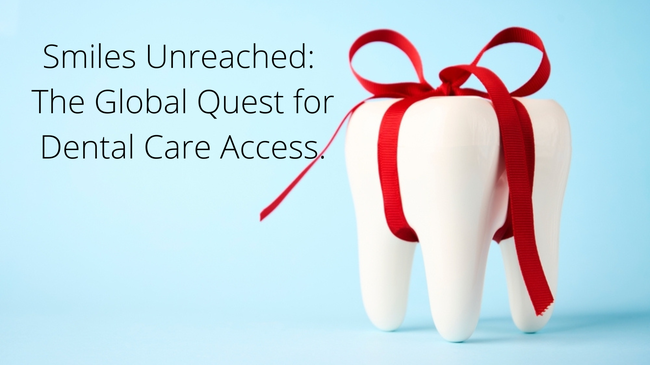Introduction
Across the spectrum of healthcare, dental treatments have a reputation for being particularly hard on the wallet. Even as technology and medical practices evolve, aiming to make healthcare more accessible , the question lingers: Why does dental care still command such high prices? From the high-tech equipment to the personalized touch of skilled professionals, there's a mosaic of factors that contribute to these costs. In this exploration, we'll delve into the nuances of the dental world and uncover the reasons behind the significant expenses associated with keeping our smiles bright and healthy .
The Costs Behind the Smile
Quality dental care is undeniably important, yet it doesn't come cheap. Whether you're considering orthodontic treatments, restorative procedures, or cosmetic enhancements, the bills can mount quickly. Insurance may cover some costs, but often there are caps, restrictions, or extensive out-of-pocket expenses.
Dental costs remain a significant concern for many, often preventing individuals from receiving essential care. Understanding why dental treatments remain expensive necessitates a look at various factors:
Education and Training Costs
Becoming a dentist requires extensive education and training. Dental school is costly, often leaving graduates with significant student debt. They might pass some of these costs onto patients in the form of higher fees.
Specialized Equipment
The tools and machinery used in dental practices, especially for advanced procedures, are high-tech and expensive. Maintenance, updates, and replacements also add up.
Labor Intensity
Many dental procedures are intricate, requiring significant time and precision. Highly skilled professionals command higher wages, and these are often reflected in treatment costs.
Sterilization and Safety
Dental practices must adhere to strict hygiene standards. The equipment, tools, and materials for sterilization are an added cost.
Dental Materials
Quality dental materials, like fillings, crowns, or braces, can be expensive. For instance, porcelain crowns or tooth-colored composite fillings generally cost more than their older, metal counterparts.
Regular Continuing Education
Dentistry is a constantly evolving field. Regular training sessions and courses to stay updated with the latest techniques and research are integral, leading to additional costs.
Insurance and Overhead Costs
Running a dental clinic involves various overhead costs, including renting space, utilities, insurance, administrative staff salaries, and more. Moreover, dealing with insurance companies can sometimes result in delayed payments or disputes over covered treatments, causing financial strain for dental practices.
Preventive Nature of Care
Unlike general healthcare, where treatment might be sought after a problem arises, dentistry emphasizes preventive care, like regular cleanings and check-ups. While this prevents bigger issues down the line, it means patients are paying regularly for preventive services.
Limited Insurance Coverage
Dental insurance often doesn't cover the entirety of many procedures, especially cosmetic ones. With more out-of-pocket expenses, the perception (and often the reality) is that dental care is more expensive.
Specializations
Many dental procedures require specialists, such as orthodontists, periodontists, or oral surgeons. Specialized care typically comes at a premium.
Dental Loans: The What and Why
Dental loans are personal loans specifically designed to cover dental procedures. Here's why they might be right for you:
Predictable Payments
Dental loans usually come with fixed interest rates, meaning consistent monthly payments.
Quick Funding
Once approved, you'll receive funds promptly, allowing timely dental interventions.
No Collateral
Unlike some other loans, dental loans are unsecured, meaning you don't risk losing any assets if you can't pay back.
How to Navigate Dental Loan Options
Assess Your Needs
Understand the exact nature of your procedure and its costs. Get quotes from dental practitioners.
Research Interest Rates
While dental loans can be a lifesaver, interest rates vary. Ensure you find competitive rates to avoid paying more in the long run.
Read the Fine Print
Look out for any hidden fees or clauses that might come back to bite!
Consider Other Financing Options
While dental loans are helpful, it's always good to weigh them against alternatives like dental savings plans, insurance, or even credit cards with promotional rates.
Success Story
Meet Lana. After years of feeling self-conscious about her smile due to a missing tooth, she decided it was time for a dental implant. The cost was intimidating, but with a dental loan, Lana managed to spread out her payments over a manageable timeframe. Today, she beams with confidence, grateful for the financial tool that helped her reclaim her smile.
Lack of access worldwide!
The World Health Organization (WHO) has expressed concerns over the years about the limited access to oral health services in many low and middle-income countries. Barriers to access include high treatment costs, an inadequate number of trained professionals, and distant geographical locations of services. The WHO's Global Oral Health Programme has cited that in some African countries, for instance, there is less than one dentist per 150,000 people.
To get an exact current percentage, you would need to refer to a combination of national health surveys, WHO reports, and other global health databases. Additionally, ongoing research and reports from dental and public health organizations would offer the most current insights into this matter.
Conclusion
Navigating the intricacies of dental costs is akin to understanding the delicate balance of art and science. On one hand, dentistry remains a field deeply rooted in precision, expertise, and the use of advanced technology, all of which come with their respective price tags. On the other, it's a sector of healthcare that holds the aesthetic , functional, and overall well-being of individuals in its hands, making its value undeniable. While the costs associated with dental care can often feel overwhelming, they underscore the multifaceted nature of the practice—from the extensive education of dental professionals to the specialized materials used in treatments. As we move forward in our healthcare journey, it's imperative to recognize these complexities, advocate for broader insurance coverages, and push for innovative solutions that ensure both the sustainability of dental practices and the accessibility of essential care. For every individual deserves the chance at a healthy smile, free from the burden of unmanageable costs.

